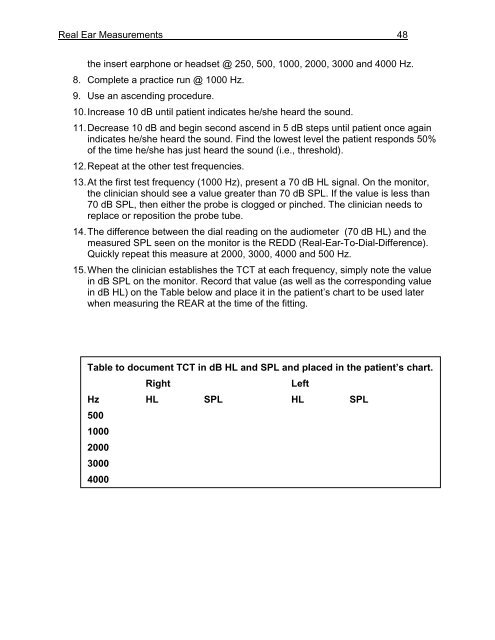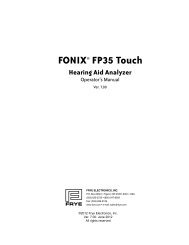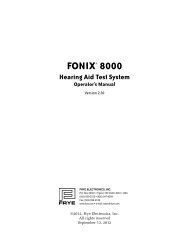Using the FONIX 7000 to Verify Coupler and Real-Ear Performance ...
Using the FONIX 7000 to Verify Coupler and Real-Ear Performance ...
Using the FONIX 7000 to Verify Coupler and Real-Ear Performance ...
Create successful ePaper yourself
Turn your PDF publications into a flip-book with our unique Google optimized e-Paper software.
<strong>Real</strong> <strong>Ear</strong> Measurements 48<br />
<strong>the</strong> insert earphone or headset @ 250, 500, 1000, 2000, 3000 <strong>and</strong> 4000 Hz.<br />
8. Complete a practice run @ 1000 Hz.<br />
9. Use an ascending procedure.<br />
10. Increase 10 dB until patient indicates he/she heard <strong>the</strong> sound.<br />
11. Decrease 10 dB <strong>and</strong> begin second ascend in 5 dB steps until patient once again<br />
indicates he/she heard <strong>the</strong> sound. Find <strong>the</strong> lowest level <strong>the</strong> patient responds 50%<br />
of <strong>the</strong> time he/she has just heard <strong>the</strong> sound (i.e., threshold).<br />
12. Repeat at <strong>the</strong> o<strong>the</strong>r test frequencies.<br />
13. At <strong>the</strong> first test frequency (1000 Hz), present a 70 dB HL signal. On <strong>the</strong> moni<strong>to</strong>r,<br />
<strong>the</strong> clinician should see a value greater than 70 dB SPL. If <strong>the</strong> value is less than<br />
70 dB SPL, <strong>the</strong>n ei<strong>the</strong>r <strong>the</strong> probe is clogged or pinched. The clinician needs <strong>to</strong><br />
replace or reposition <strong>the</strong> probe tube.<br />
14. The difference between <strong>the</strong> dial reading on <strong>the</strong> audiometer (70 dB HL) <strong>and</strong> <strong>the</strong><br />
measured SPL seen on <strong>the</strong> moni<strong>to</strong>r is <strong>the</strong> REDD (<strong>Real</strong>-<strong>Ear</strong>-To-Dial-Difference).<br />
Quickly repeat this measure at 2000, 3000, 4000 <strong>and</strong> 500 Hz.<br />
15. When <strong>the</strong> clinician establishes <strong>the</strong> TCT at each frequency, simply note <strong>the</strong> value<br />
in dB SPL on <strong>the</strong> moni<strong>to</strong>r. Record that value (as well as <strong>the</strong> corresponding value<br />
in dB HL) on <strong>the</strong> Table below <strong>and</strong> place it in <strong>the</strong> patient’s chart <strong>to</strong> be used later<br />
when measuring <strong>the</strong> REAR at <strong>the</strong> time of <strong>the</strong> fitting.<br />
Table <strong>to</strong> document TCT in dB HL <strong>and</strong> SPL <strong>and</strong> placed in <strong>the</strong> patient’s chart.<br />
Right Left<br />
Hz HL SPL HL SPL<br />
500<br />
1000<br />
2000<br />
3000<br />
4000
















